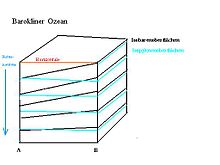Baroclinity
Under baroclinicity it is understood that each faces the same pressure ( isobars ) and in each case the same temperature ( isotherms ) are not parallel to each other, but that they intersect. There is therefore a pressure gradient on a temperature surface and vice versa. The counterpart to baroclinicity is barotropy .
In baroclinic stratified air masses , the occurrence of laterally directed, i.e. horizontal forces leads to the formation of currents in a horizontal direction as well. As a result, the currents in the earth's atmosphere and in the ocean are not constant horizontally. A baroclinic stratification gives rise to the acceleration of circulation in the form of cyclones ( vortex- shaped flow fields ) and to dynamic instabilities.
Baroclinity in the atmosphere
Baroclinic stratifications typically occur in the area of fronts , between air masses of different temperatures. They also play a decisive role in the atmospheric circulation in the formation of cyclone- anticyclone systems in the area of west wind drift .
Baroclinity in the ocean
In the ocean one assumes baroclinic stratification in faster surface currents . Based on the baroclinic stratification and the basic equations of geostrophy , the relative flow velocities can be calculated from the density differentiated at two points.
To the drawing:
The isopycnene (surfaces of the same density) and isobaric surfaces (surfaces of the same pressure) are inclined to each other and intersect. The isobar planes are parallel to the sea surface at shallow depths. With increasing depth, however, their inclination decreases, as the mean density of the water column above point A is greater than that above B. Since the isobaric surfaces become more and more horizontal with depth, the pressure gradient and, associated with it, the geostrophic flow continue to decrease until , when the isobar surfaces are horizontal from a certain depth, there are no more geostrophic currents.
literature
- Walter Roedel: Physics of our environment: the atmosphere . Springer, Berlin / Heidelberg 2000, ISBN 3-540-67180-3 .
- Gösta H. Liljequist, Konrad Cehak: General Meteorology . Springer, Heidelberg 1984, ISBN 3-540-41565-3 .

